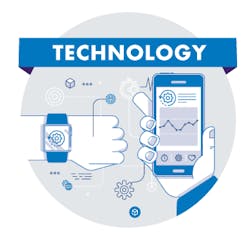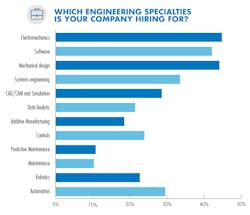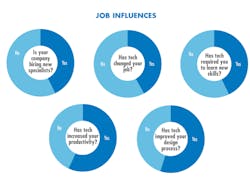Chapter four of this year’s Salary Career Survey focuses on the new technology that has entered the engineering world. These new technological innovations include the widespread adoption of 3D printing, robots, and Internet of Thing (IoT) devices. Adoption of these innovations has shifted work processes, design, production, and testing in many engineering firms. Let’s explore how different engineers view the new innovations and if they are beneficial to the engineering landscape.
Tech Innovations Hit the Workspace
According to our survey, the top tech innovation to infiltrate the engineering workspace is 3D printing at 74%. Behind that IoT devices came in at 33%, artificial intelligence (AI) at 20%, and collaborative robots at 13.5%. A small portion at 29% stated that no new tech innovations have entered their work environment. Outside of these tech innovations, other systems gaining ground in the engineering field are computer-aided design and manufacturing (CAD/CAM), model-based design, simulation, collaborative software, machine vision, and augmented and virtual reality tools.
When asked if their companies are hiring new individuals to fill these roles, 43% answered yes. The main focus on new hires is in electromechanics or electronic systems at 45%. This is closely followed by mechanical design at 44%, software engineers at 42%, systems engineering at 33%, automation at 30%, CAD/CAM specialists at 29%, and lastly robotic engineers at 23%.
Production Processes Change Under New Tech
Our readers have felt the impact of these new technologies, but perhaps the pace is slower than advertised. Only 42% have felt that their jobs have changed due to the introduction of new technology; 43% have to learn new skills or acquire new certifications to use said technologies.
The new tools have pushed the design process to more prototyping of parts. Several readers in our survey responded that they use 3D printing to create prototypes or tooling for production parts. One reader states that “3D printing has changed how we approach prototyping and development testing,” and another notes that “3D printing allows us to increase the output of tooling production with very low cost.”
Automation and systems engineering have also been impacted by new tools and technologies. The role of automation in today’s engineering society is to create enhancements in the design and manufacturing sectors. This includes data gathering, simulation of production, sensor equipment, and predictive maintenance. One reader responds that “3D printing and automation has made my job much more challenging. Combining parts, preparing production fixturing, and time to market, all play a role.”
Automation is also forcing companies to examine their entire production process and look for opportunities to enhance production along the entire manufacturing chain. As one reader explains, “Automation has us focusing in some areas that we had not focused on in the past. However, that is the nature of process development. We are always looking for new opportunities.”
These new opportunities are leaning on IoT analytics and data. The need for data analysts will grow as more devices become connected and offer data gathering services. One engineering reader talks about how important it is to adapt to the world of IoT: “I have completely re-invented myself as an analytics consultant…in an attempt to capitalize on demand for the new tech such as machine learning, predictive analytics, etc.”
Has New Tech Evolved the Work Process?
Asking engineers if the new tech has improved their work, public opinion is closely spilt down the middle but leaning towards the positive side. 57% believe that productivity has improved and 55% believe that the design process is better as a result of new technology with 3D printing being the most favored new tool. The ability to rapid prototype parts and create simple tooling fixtures, has reduced the production time and helped turn around design ideas that much quicker.
As one engineer says in our survey responses, “It’s become much easier to draw out, visualize, and build up our systems now that we have 3D printing. We can actually build scale models of the project and look at all the possible problems that we may run into…We have in many cases manage to save weeks of time in the final design with these additions to our activities.”
Design cycles involving 3D printing and CAD tools are faster and allow for more iterations. CAD tools like finite element analysis and simulation help predict product behavior in the real world and can accurately point out design flaws. This saves money in the end because testing is less costly and more efficient. In short, the ability to visualize parts in a digital setting has helped the production of parts in the real world.





